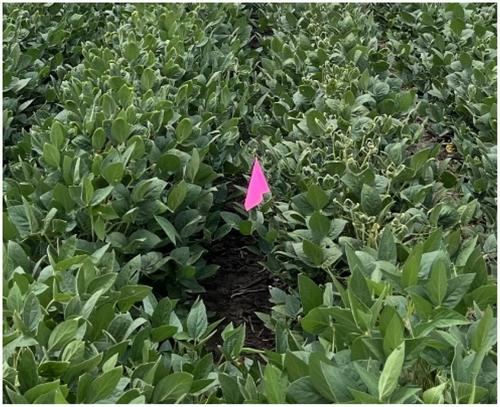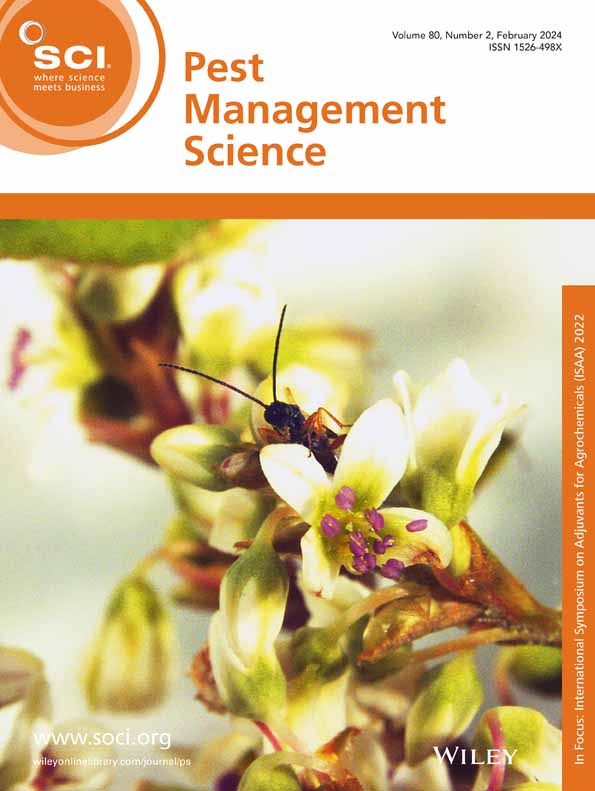大豆(Glycine max L.)冠层对模拟麦草畏蒸汽漂移的响应
IF 3.8
1区 农林科学
Q1 AGRONOMY
引用次数: 0
摘要
背景:随着耐麦草畏(DT)大豆[Glycine max (L.)]的商业化,对敏感植被暴露于脱靶麦草畏的担忧已经升级。稳定。]和棉花(棉)在田间尺度上,植物损伤的光谱反应是一个关键的知识缺口,可以帮助研究人员了解麦草畏在环境中的命运。非DT大豆因其极端敏感性而成为理想的前哨作物。通过田间试验研究了麦草畏蒸气漂移对大豆冠层的影响。目的是在野外条件下,利用陆基遥感,确定EM的哪些区域与麦草畏损伤的大豆冠层相关。结果麦草畏用量仅为标记用量的万分之一,8天后出现大豆损伤。模拟水汽漂移与单通道红边反射光谱、营养指数过量红(ExR)和绿叶指数(GLI)之间存在相关性。该研究证明了在大豆中检测麦草畏脱靶蒸汽漂移损伤的潜力,麦草畏处理后的反射光谱在所有光谱通道上都观察到了。结论利用单光谱通道和营养指标可实现麦草畏损伤和耐麦草畏大豆冠层的鉴别。这些发现为遥感卫星提供了一种可能性,遥感卫星在识别作物对景观的胁迫方面有充分的记录,可以用来了解在DT大豆上过量施用(OTT)后麦草畏伤害的程度。遥感技术可用于监测除草剂脱靶危害和减轻麦草畏漂移的影响。©2025作者。《病虫害管理科学》由John Wiley &出版;我代表化学工业协会的儿子有限公司。本文章由计算机程序翻译,如有差异,请以英文原文为准。

Soybean (Glycine max L.) canopy response to simulated dicamba vapor drift using unmanned aerial sensing
BACKGROUNDConcerns about off‐target dicamba exposure to sensitive vegetation have escalated following the commercialization of dicamba‐tolerant (DT) soybean [Glycine max (L.) Merr.] and cotton (Gossypium hirsutum L.) The spectral response of plant injury at the field scale is a crucial knowledge gap that may help researchers understand dicamba's fate in the environment. Non‐DT soybean is the ideal sentinel crop owing to its extreme sensitivity. Field experiments were conducted to characterize the reflectance spectra associated with dicamba vapor drift injured soybean canopies. The objective was, under field conditions and using land‐based remote sensing, to determine what regions of the EM correlate to dicamba‐injured soybean canopies.RESULTSSoybean injury was observed 8 days after treatment at only 1/10000th of a labeled use rate of dicamba. Correlations between simulated vapor drift and reflectance spectra at the single channel red‐edge and vegetative indices excess red (ExR) and green leaf index (GLI) were observed. The study demonstrates the potential for detecting off‐target dicamba vapor drift injury in soybean, with reflectance spectra following dicamba treatments observed at all spectral channels.CONCLUSIONSDifferentiating dicamba‐injured from dicamba‐tolerant soybean canopies can be achieved using single spectral channels and vegetative indices. These findings usher in the possibility that remote sensing satellites, which are well‐documented for identifying crop stress on the landscape, could be harnessed to understand the extent to which dicamba injury appears following over‐the‐top (OTT) application in DT soybean. Remote sensing technology could be instrumental in monitoring off‐target herbicide injury and mitigating the effects of dicamba drift. © 2025 The Author(s). Pest Management Science published by John Wiley & Sons Ltd on behalf of Society of Chemical Industry.
求助全文
通过发布文献求助,成功后即可免费获取论文全文。
去求助
来源期刊

Pest Management Science
农林科学-昆虫学
CiteScore
7.90
自引率
9.80%
发文量
553
审稿时长
4.8 months
期刊介绍:
Pest Management Science is the international journal of research and development in crop protection and pest control. Since its launch in 1970, the journal has become the premier forum for papers on the discovery, application, and impact on the environment of products and strategies designed for pest management.
Published for SCI by John Wiley & Sons Ltd.
 求助内容:
求助内容: 应助结果提醒方式:
应助结果提醒方式:


